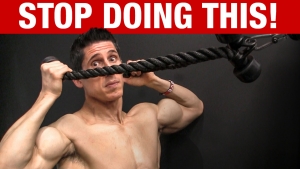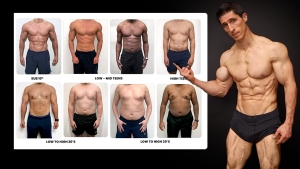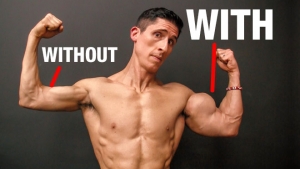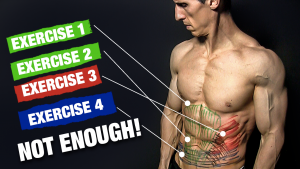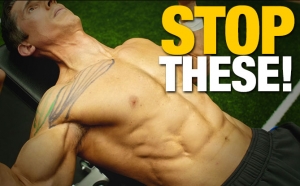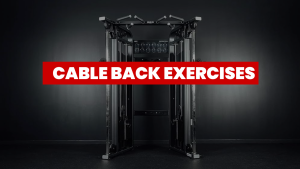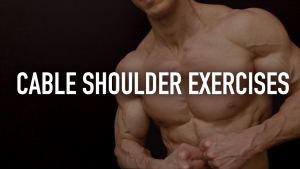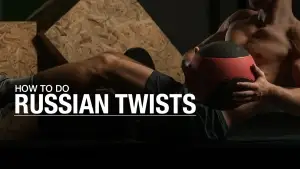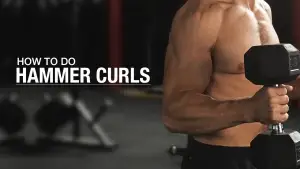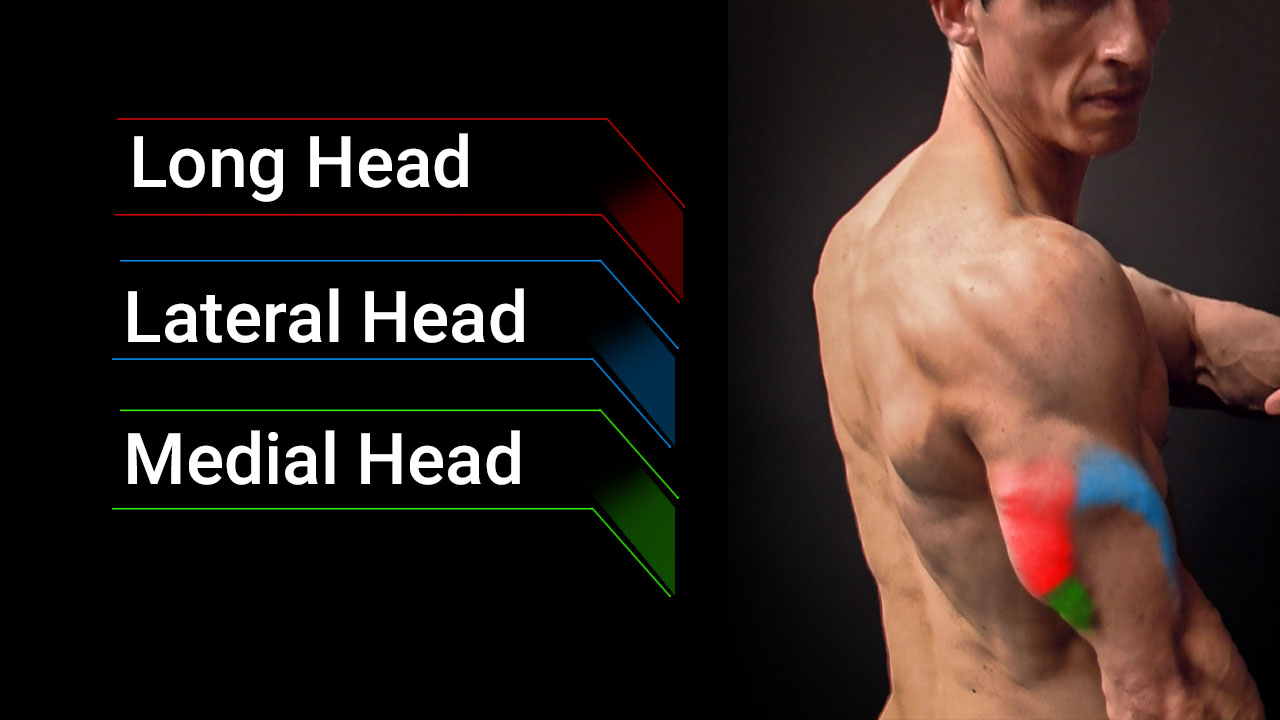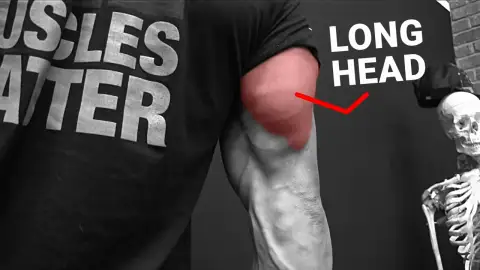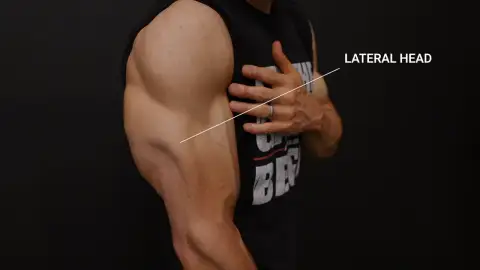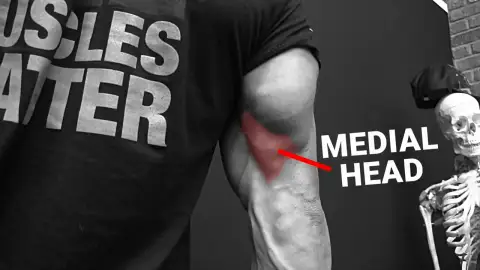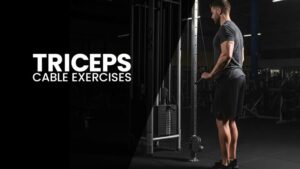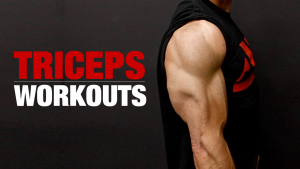
WHY DO THE JM PRESS?
Even worse, no matter how hard you try, your bench numbers haven’t improved. Sound familiar?
If your upper arms aren’t growing and your bench press hasn’t budged in weeks, there’s a good chance your weak link is hiding in plain sight: your triceps.
And let me be clear, you’re not going to fix that with another set of pushdowns or by adding 10 more pounds to your traditional bench. You need to train smarter, not just heavier.
Today, I’m breaking down Dumbbell JM Presses.
The JM Press is one of the most effective exercises for building massive triceps, boosting bench press lockout strength, and fixing the problem that’s been holding your progress hostage.
JM PRESS: MUSCLES WORKED
Most lifters throw heavier weight around hoping to “feel the burn” and call it a day.
But if you want to build muscle, you need more than just effort. You need control. That’s where the mind-to-muscle connection comes in.
The JM Press isn’t a show-off movement for your workout split. You can’t cheat your way through it.
You have to slow down, stay locked in, and focus on the tension in the triceps from the first inch of the rep to the last inch of the lockout.
Done right, it forces you to dial into the movement pattern, engage the right muscles, and reinforce proper technique with every single rep.
This isn’t just about adding size to your arms. It’s about developing smarter, more effective upper body strength.
Let’s look at the muscles the JM Press targets and why this lift hits them harder than your standard bench or skull crusher ever could.
LONG HEAD
The long head of the triceps brachii muscle is the biggest of the three and the most often neglected.
It runs from your shoulder blade (scapula) down to your elbow joint, making it the only head that crosses the shoulder joint.
That means it plays a role in both elbow extension and shoulder stabilization.
When you’re in the starting position of the JM Press, this head is doing the heavy lifting.
It controls the eccentric load and drives the bar back up with power.
You want lockout strength? You train the long head.
LATERAL HEAD
The lateral head is the one everyone wants to see. It is the outer head that creates that signature horseshoe shape when you flex.
It originates on the upper arm bone and powers elbow extensors, especially at the top end of the lift.
The JM Press calls in the lateral head to take over when the bar hits that sticking point, making it a great bench press accessory for pushing past plateaus.
If you’re stuck halfway through your bench press rep, your lateral head is likely the weak link.
MEDIAL HEAD
Buried underneath the other two, the medial heads don’t get the attention they deserve but they are important for elbow flexion strength and stabilizing the bar through the full range of motion.
It starts on the back of your upper arm bone and connects to the bony point of your elbow.
The medial head stays active throughout the lift, even during the hardest reps with the heaviest weights.
It’s your endurance muscle, keeping your arm stable and your triceps tendon firing efficiently.
Without it, you’re not just weak, you’re injury prone.
HOW TO DO THE JM PRESS
A lot of lifters butcher this movement. They either turn it into a sloppy Close-Grip Bench Press, or they lean too far into a skull crusher and wreck their elbow joints in the process.
The JM Press is kind of like a bench press-skull crusher hybrid, not a confused version of both.
You need precision, control, and an understanding of the movement path if you want to get the killer tricep gains without grinding your elbows into dust.
Here’s your step-by-step guide to doing the JM Press with proper technique and making it one of the smartest bench press assistance exercises in your arsenal.
I’m also going to include a breakdown on how to modify the JM Press.
JM PRESS

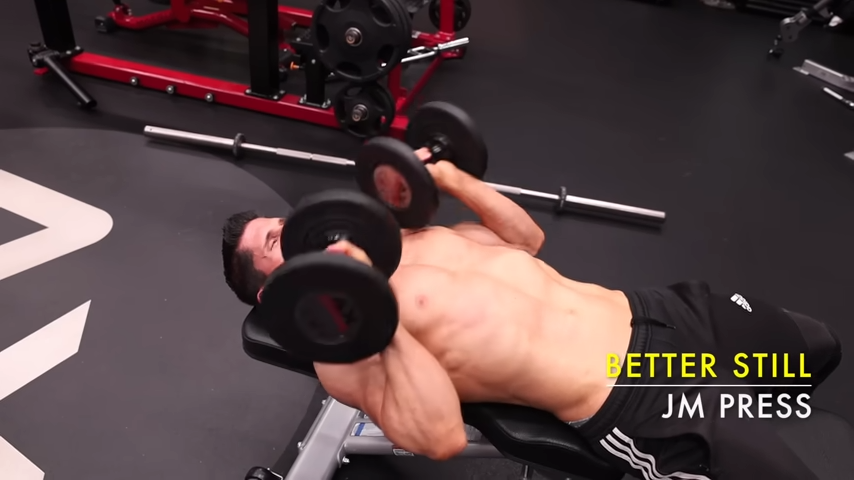
HOW TO DO THE JM PRESS:
- Use a flat bench or adjustable bench. A solid body position starts with your feet flat, shoulder muscles packed down, and a slight arch in your low back just like your standard bench press position.
- Grab a pair of dumbbells with a pronated grip, palms facing forward, not facing each other.
- Start with the dumbbells directly over your chest roughly shoulder width apart.
- Elbows should be tucked, not flared, and your wrists stacked over your elbows.
- Lower the dumbbells as you lead with your elbows. As the dumbbells come down, they should travel toward your upper shoulder, focusing all of the attention in your triceps.
- Pause at the bottom and then contract your triceps to reverse the movement, pressing the dumbbells back up.
WHAT MAKES IT EFFECTIVE: The JM Press combines the pressing power of a close-grip bench press with the isolation of a skull crusher, placing the triceps under constant tension through a controlled range of motion. By emphasizing elbow flexion and minimizing shoulder involvement, it directly hits all three heads of the triceps, especially the long and medial heads, while reducing stress on the joints.
MODIFIED JM PRESS

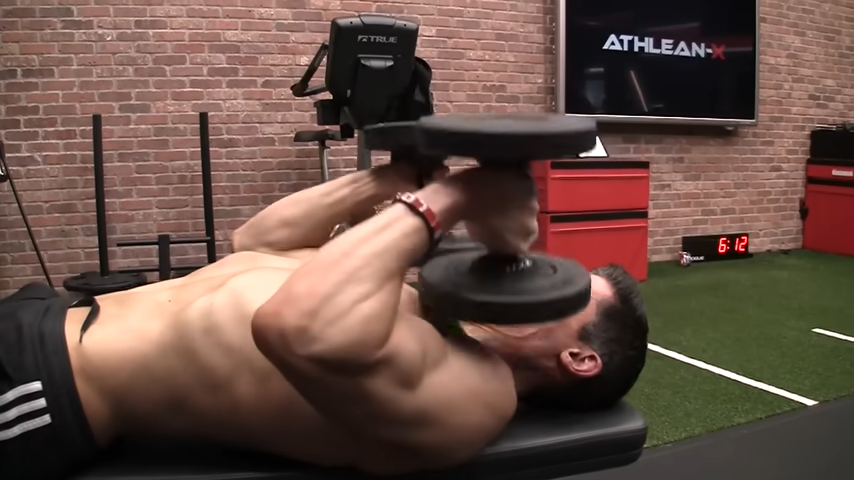
HOW TO DO THE MODIFIED JM PRESS:
- Grab two dumbbells with a neutral grip, palms facing each other. This is not a press or a fly. It’s a hybrid movement that keeps your wrists in a safer alignment while still hitting the triceps tendon hard.
- Hold the dumbbells directly above your shoulders with your arms extended. Your hands should be roughly shoulder width apart.
- Bend only at the elbows. No shoulder movement and no flaring. The dumbbells should lower in a straight vertical line, coming down toward the top of your shoulders.
- Keep the dumbbells tight to the body. You’ll feel the stretch in the triceps at the bottom, but don’t let the dumbbells rest on your shoulders. Stay active and keep the muscle under tension.
- Press the dumbbells straight back up along the same vertical path. Your elbow angle stays tight, and the focus is on pressing through the triceps, not launching with your chest muscles.
- At the top, stop just short of full lockout to keep tension in the triceps and repeat the exercise.
WHAT MAKES IT EFFECTIVE: The Modified JM Press isolates the elbow joint with a controlled, vertical movement while the neutral grip reduces stress on the shoulders and wrists. This variation keeps tension locked on the triceps growth, making it ideal for building strength and size without compromising joint health.
JM PRESS EXTENSION

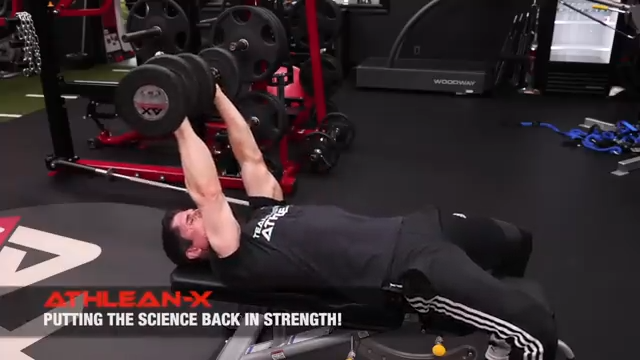
HOW TO DO THE JM PRESS EXTENSION:
- Lie on a flat bench holding two dumbbells with the dumbbells slightly turned inward. Begin with the dumbbells held directly above your chest with arms extended, elbows tucked in.
- Bend at the elbows and lower the dumbbells in a straight bar path down and slightly forward, guiding them to rest gently on the top of your shoulders. Keep elbows tight to the body and avoid flaring.
- From this bottom position, perform a triceps extension by pressing the dumbbells up and slightly back, keeping the movement tight.
- Slowly bring the dumbbells back down to the shoulder position, controlling the descent and maintaining elbow tension.
- From the shoulders, press the dumbbells back up in a straight line above the chest to return to the starting position.
- Grab two dumbbells with a neutral grip, palms facing each other. This is not a press or a fly. It’s a hybrid movement that keeps your wrists in a safer alignment while still hitting the triceps tendon hard.
- Hold the dumbbells directly above your shoulders with your arms extended. Your hands should be roughly shoulder width apart.
- Bend only at the elbows. No shoulder movement and no flaring. The dumbbells should lower in a straight vertical line, coming down toward the top of your shoulders.
- Keep the dumbbells tight to the body. You’ll feel the stretch in the triceps at the bottom, but don’t let the dumbbells rest on your shoulders. Stay active and keep the muscle under tension.
- Press the dumbbells straight back up along the same vertical path. Your elbow angle stays tight, and the focus is on pressing through the triceps, not launching with your chest muscles.
- At the top, stop just short of full lockout to keep tension in the triceps and repeat the exercise.
WHAT MAKES IT EFFECTIVE: This move extends time under tension by splitting the rep into two distinct phases, forcing the triceps to work through multiple angles in one continuous set. The extension phase at the bottom hammers the long head and medial head of the triceps, which is exactly what you need for a stronger bench lockout and better muscle-building.
JM PRESS COMMON MISTAKES
The JM Press isn’t just another bench press variation you can muscle through with sloppy form.
It’s a precision lift, and when done right, you’ll be building triceps muscle size, improving bench press strength, and breaking through those dreaded bench press plateaus.
But it can be easy to screw it up if you’re not paying attention to form and cues. Here are the most common mistakes of the JM Press.
TURNING IT INTO A REGULAR BENCH PRESS
This isn’t your conventional bench or your favorite bench press motion.
If your form starts drifting toward a standard press with the bar or dumbbells lowering to your chest, elbows flaring, and the shoulders and chest taking over, you’re defeating the entire purpose of the JM Press.
Keep the bar or dumbbells traveling down and slightly forward, toward the upper chest, not the mid-chest.
Focus on elbow flexion-extension, not shoulder drive. This is all about triceps exercises, not for chest muscles.
FLARING THE ELBOWS
The JM Press demands strict elbow positioning. If your elbows start drifting out to the sides, you shift tension away from the triceps and put your shoulder rotation and tendon strength at risk.
Keep your elbows tucked close to your sides at about a 45-degree angle. Think “press with your triceps, not your chest or shoulders.”
GOING TOO HEAVY, TOO SOON
This isn’t a max-effort lift. Trying to hammer it with heavy weight like your main bench press movement will wreck your form and your joints, especially novice lifters or someone dealing with a pre-existing shoulder injury.
Nail your mindful practice technique first. Use a moderate weight range that allows clean reps and full control through the lockout range. Treat it like a skill-based lift, not a PR attempt.
WRONG GRIP WIDTH OR SETUP
If your barbell press with hands shoulder width apart turns into a narrow grip hand placement, or flares beyond shoulder width, you’re either missing the angle or stressing the joints.
And without a stable body posture, you’re fighting the bench instead of the rep.
Set up with the bar or dumbbells at shoulder width and maintain a strong, consistent path.
If you’re using dumbbell presses, keep your hands above the shoulders with controlled symmetry throughout the lift.
SKIPPING THE LOCKOUT OR OVEREXTENDING
Half-repping or snapping into full lockout defeats the purpose. You either cheat the triceps activation, or you dump pressure into the elbow joints. Both are bad options.
Control the tempo. Press to just before full extension to maintain muscle tension, then reverse. The goal is stimulation, not joint stress.
The JM Press is one of the most effective and overlooked exercises for building stronger triceps that translates directly to better bench press performance.
By combining controlled elbow flexion with minimal shoulder involvement, it hits all three heads of the triceps while keeping your joints safer than most pressing movements.
Add it to your training for 2-3 workouts per week, focus on form over ego, and you’ll break through plateaus while building serious upper body strength.
Check out our complete line of ATHLEAN-RX Supplements and find the best training program for you based on your fitness level and goals.
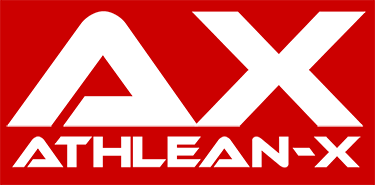
- The JM Press is a joint-friendly triceps builder that targets all three heads while minimizing shoulder and chest involvement for better isolation, lockout strength, and elbow stability.
- Its controlled range of motion makes it a safer alternative to the Barbell Skull Crusher without sacrificing results. Here’s how to perform it:
- Lie on a flat bench with a dumbbell in each hand and your palms facing forward like a standard bench press.
- Start with the dumbbells held above your chest, with hands roughly shoulder width apart and elbows tucked in.
- Lower the dumbbells by bending only at the elbows, allowing them to travel down and slightly forward toward the upper chest or shoulder line.
- Pause when the dumbbells reach just above the shoulders, keeping tension in the triceps and elbows pointed forward.
- Press the dumbbells back up along the same path, stopping just short of full lockout to keep constant tension.
JM PRESS FAQ
The JM Press is built for one thing: fixing weak triceps so you can finally break through those bench press training plateaus.
It’s a hybrid movement designed to maximize elbow flexion and build serious strength, especially for lifters who struggle to finish at the top of a press.
It doesn’t matter if you're an elite powerlifter or a weekend warrior, it delivers effective and injury-free workouts that improve body composition, joint integrity, and raw pressing power.
If you care about your elbows, yes.
While skull crushers overload the triceps through a deep stretch, they also crank up the joint stress, especially if your weight selection is off.
The JM Press gives you similar activation with better control, a safer step process, and a more joint-friendly range of motion, making it the go-to muscle-building workout for a broad range of lifters from longer-armed lifters to pros with years under the bar.
The close-grip press is more of a chest muscle training exercise with the bar at shoulder width, involving more shoulder rotation and bench press grip dynamics.
The JM Press shifts the focus entirely to the triceps, with a tighter step execution, reduced chest involvement, and a unique movement path that emphasizes the elbow joint from the first rep to the last.
Think of it as a precision tool for your triceps, not just another press.
If you want to lift heavier, protect your joints, and grow your arms, then yes, the JM Press is absolutely worth it.
It’s an exercise among powerlifters and serious lifters alike because it reinforces clean form, strengthens tendon stability, and improves performance.
It targets the exact sticking points that limit your bench press and builds real lockout strength where it counts.
Looking for an effective triceps builder? The JM Press belongs in your program.
REFERENCES
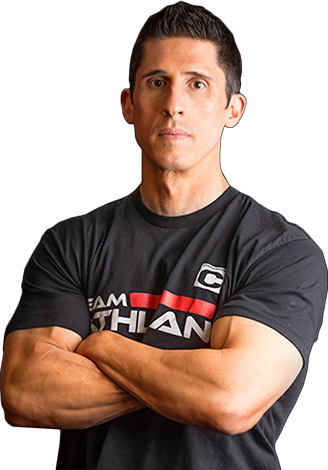
Jeff Cavaliere M.S.P.T, CSCS
Jeff Cavaliere is a Physical Therapist, Strength Coach and creator of the ATHLEAN-X Training Programs and ATHLEAN-Rx Supplements. He has a Masters in Physical Therapy (MSPT) and has worked as Head Physical Therapist for the New York Mets, as well as training many elite professional athletes in Major League Baseball, NFL, MMA and professional wrestling. His programs produce “next level” achievements in muscle size, strength and performance for professional athletes and anyone looking to build a muscular athletic physique.
